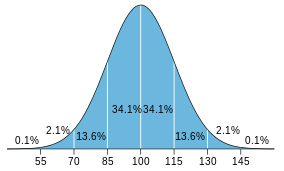Main Content
Lesson 1: Abnormal Behavior
Criteria for Determining Abnormality
According to the textbook, mental disorders involve behavior that departs from some norm and harms the affected individual or others (Sue et al., 2016). In this section we will go over what are called the “4D Criteria”, or the four major factors involved in judging psychopathology:
Distress
This involves experiencing unpleasant mental or physical health symptoms. The textbook does not mention physical symptoms but I’m adding it here because physical discomfort or distress can worsen psychological distress and vice versa; e.g., chronic pain is a huge issue in the mental health world right now.
Many of the diagnostic criteria in the DSM-5 involve distressing symptoms such as irritability or sadness.
Deviance
Abnormal behaviors differ from the typical experiences of most people, and can sometimes deviate from the shared, agreed-upon reality most of us encounter.
Hallucinations and delusions are considered psychologically deviant experiences because they are not something that one typically encounters in normal human experience. Thus, hearing the voice of Satan or believing that you are a famous Hollywood actor when you are not are considered deviant and abnormal.
Delusions = False beliefs held despite contradictory, objective evidence.
A clinical delusion is one that someone believes even when it is clearly wrong. For example, suppose that a man has a delusion of jealousy and he believes that his partner is cheating on him. He is 100% convinced that his partner is cheating on him and he even hires a private investigator to follow them. The man will still be convinced of the infidelity even if the private investigator shows him definitive proof that his partner is not cheating.
We will learn more about hallucinations and delusions (which are known as “positive symptoms”) when we discuss psychotic disorders in Lesson 12.
Another form of deviance is statistical deviation, or being discrepant based solely on raw numbers. Let’s consider I.Q. scores as an example of this. The average I.Q. score is 100, and a standard deviation is 15. That means that someone’s I.Q. score is statistically deviant if it is below 85 or above 115. You can probably think of some issues with using statistical deviation as a criterion for abnormality: judging someone based solely on a number does not consider context, and it may lead to pathologizing people who are actually high functioning. Can you think of other problems with this approach? Can you think of potential benefits of statistical deviation?

Dysfunction
This domain refers to how well one can function in life. Life functioning is a very important factor that clinicians need to take into account when assessing a client. For example, I work at a college counseling center and I always ask my student-clients if their grades dropped off recently because of their symptoms – that’s one way of judging the impact that their mental health problems may be having on their life.
The DSM-IV-Text Revision (American Psychiatric Association, 2000) featured something known as the “Global Assessment of Functioning” or GAF scale. A client’s GAF score was determined by his or her level of distress or symptomology (which is obviously related to the Distress domain from earlier) combined with his or her level of life functioning, which is this Dysfunction domain.
There are various areas of life functioning that one can consider: school or academic functioning, occupational functioning, social relationships, and day to day tasks such as grooming or driving a car are common examples.
Dangerousness
This domain is fairly self-explanatory: can the person be considered a danger to self or others? It is rare for mentally ill individuals to commit violent crimes (Sue et al., 2016), but it’s still important for clinicians to assess for dangerousness. We will discuss this issue in more detail in Lesson 2. For now, however, just know that if someone is dangerous then they can certainly be considered abnormal.
